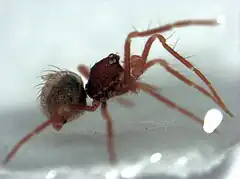| Micropholcommatinae | |
|---|---|
 | |
| Parapua punctata | |
| Scientific classification | |
| Domain: | Eukaryota |
| Kingdom: | Animalia |
| Phylum: | Arthropoda |
| Subphylum: | Chelicerata |
| Class: | Arachnida |
| Order: | Araneae |
| Infraorder: | Araneomorphae |
| Family: | Anapidae |
| Subfamily: | Micropholcommatinae Hickman, 1943 |
The Micropholcommatinae are a subfamily of araneomorph spiders in the family Anapidae. They were previously treated as the family Micropholcommatidae.[1][2] Micropholcommatins are extremely small, with body lengths typically between 0.5 and 2 mm. They are usually found among leaf litter or moss.[3]
Distribution
Many genera are endemic to New Zealand and Australia, with others found also in South America.
Taxonomy
The families Micropholcommatidae and Textricellidae were synonymized with the Symphytognathidae by Forster in 1959, but again split from it in 1977.[4] Later they were considered to be only one family, namely Micropholcommatidae, by Platnick & Forster in 1986.[5] They were synonymized with Anapidae by Schütt in 2003[6] and by Lopa et al. in 2011,[1][2] a change that has been accepted by the World Spider Catalog.[7]
References
- 1 2 Lopardo, L.; Giribet, G. & Hormiga, G. (2011). "Morphology to the rescue: molecular data and the signal of morphological characters in combined phylogenetic analyses — a case study from mysmenid spiders (Araneae, Mysmenidae), with comments on the evolution of web architecture". Cladistics. 27 (3): 278–330. doi:10.1111/j.1096-0031.2010.00332.x. PMID 34875780. S2CID 85647657.
- 1 2 Hormiga, Gustavo & Griswold, Charles E. (2014). "Systematics, Phylogeny, and Evolution of Orb-Weaving Spiders". Annual Review of Entomology. 59 (1): 487–512. doi:10.1146/annurev-ento-011613-162046. PMID 24160416.
- ↑ Rix, Michael; Harvey, Mark & Roberts, J. Dale (2008). "Molecular phylogenetics of the spider family Micropholcommatidae (Arachnida: Araneae) using nuclear rRNA genes (18S and 28S)". Molecular Phylogenetics and Evolution. 46 (3): 1031–1048. doi:10.1016/j.ympev.2007.11.001. PMID 18162409.
- ↑ Forster, R.R. & Platnick, N.I. (1977). "A review of the spider family Symphytognathidae (Arachnida, Araneae" (PDF). American Museum Novitates (2619): 1–29. Retrieved 2017-03-03.
- ↑ Platnick, N.I. & Forster, R.R. (1986). "On Teutoniella, an American genus of the spider family Micropholcommatidae (Araneae, Palpimanoidea)" (PDF). American Museum Novitates (2854): 1–9. Retrieved 2017-03-03.
- ↑ Schütt, K. (2003). "Phylogeny of Symphytognathidae". Zoologica Scripta. 32: 129–151. doi:10.1046/j.1463-6409.2003.00103.x. S2CID 84908326.
- ↑ "Family: Anapidae Simon, 1895". World Spider Catalog. Natural History Museum Bern. Retrieved 2017-03-03.
Further reading
- Forster, R.R. (1959). "The spiders of the family Symphytognathidae". Transactions of the Royal Society of New Zealand 86: 269–329.
- Griswold, C.E., Ramírez, M.J., Coddington, J.A. & Platnick, N.I. (2005) "Atlas of phylogenetic data for entelegyne spiders (Araneae: Araneomorphae: Entelegynae) with comments on their phylogeny". Proceedings of the California Academy of Sciences 56 Suppl. 2: 1–324.
- Penney, David; Dierick, Manuel; Cnudde, Veerle; Masschaele, Bert; Vlassenbroeck, Jelle; van Hoorebeke, Luc & Jacobs, Patric (2007). "First fossil Micropholcommatidae (Araneae), imaged in Eocene Paris amber using X-Ray Computed Tomography." Zootaxa 1612: 47-53. PDF Abstract